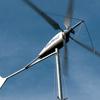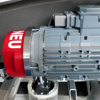
Efficiency and reliability
The EasyWind was developed especially for extreme climate conditions and has proven its reliability for more than 20 years in more than 100 locations.
Maximum yield, minimal effort
With our technology, we provide small wind turbines that can be used extremely efficiently and reliably as energy generators for self-supply.
The EasyWind 6 has been on the market for more than 20 years and has up until now been installed in more than 300 different locations. Our EasyWind 6 AC is certified as an IEC 614000-2 SWT Class 1 wind turbine. It was the first certified wind turbine in Germany and is certified for all wind classes. Due to its patented passive pitch-control, the turbine does not need to be switched off during stormy weather and hereby provides a constant and stable energy production even during extreme weather.
The installation is performed by two EasyWind Service partners within one day. The EasyWind 6 only requires minimum maintenance and can be manually mounted on to either a cement or a steel foundation. As a special model, the 7m high roof version can be mounted without bracing.
No Switch-offs during storms
The patented passive pitch function allows for a stable energy generation even during the strongest winds and is also stormproof without a cement foundation.
Types of the EasyWind 6
The EasyWind 6 is a robust small wind turbine and currently only sold as a line-commutated AC version. Recently, rotators specifically for weak wind areas have been added to the portfolio.
The AC-version is a wind turbine, which, parallel to the public grid, primarily covers the self-supply of households and companies with electricity, wind power and heating, but also allows to feed electricity into the grid.
EasyWind 6 Setups
The installation via a cable winch or hydraulic system guarantees a cost-efficient and fast erection. For the foundation, either a steel root or cement is used.
The Monotower does not require anchoring cables which results in both saving of space and improved visual appearance. Another advantage is that no cement foundation is required. Only a 1,60m and 4,20m x 4,20m large excavation pit will be dug in which the steel root of the tower will be inserted. Afterwards, the pit is filled with the previously excavated soil and condensed with the help of a concrete vibrator.
The tower is wired on all four sides through steel ropes. This results in an overall surface of 10m x 10m for the entire installation. For the wired tower a cement foundation (strip foundation) is required. This setup has proven to be successful for many years and is also more cost-effective than the Monotower. The client, however, must make sure to check the rope tension every three months.

